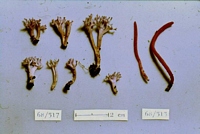|
 Clavaria sp. 4 Clavaria sp. 4
BiostatusPresent in region - Indigenous
Images (click to enlarge)
Caption: Fig. 38 Clavaria Taxon no. 4, spores. Horak no. 68/513 (ZT). Scale bar = 5 µm | 
Caption: Microfiche 1-30. Clavaria Taxon No. 4. (right, Horak no. 68/513). Ramariopsis pulchella. (Left, Horak no. 68/517). |
Article: Petersen, R.H. (1988). The clavarioid fungi of New Zealand. New Zealand Department of Scientific and Industrial Research, Bulletin 236: 170 pp. Wellington:.
Description: Fruit bodies up to 55 x 3 mm, simple clubs, solitary to gregarious, not cespitose, terete,
bright violet-purple all over (apparently near "pomegranite-purple" or "spinel red"). Stipe
rounded at base, pale lavender where protected, terete. Club appearing waxy; apex rounded.
Taste and odour not recorded.
Tramal hyphae of club 3-15 µm diam., inflated, thin-walled, clampless, parallel.
Subhymenium extensive, pseudoparenchymatous. Hymenium thickening; basidia 65-85 x 8-9 µm, clavate, bifurcate; contents opalescent
or with minute acicular crystals at maturity; sterigmata 4, slender, up to 6 µm long, curved-ascending.
Spores (Fig. 38) 8.6-10.4x5.8-6.8 µm (E = 1.39-1.53; Em = 1.46; Lm = 9.24 µm), broadly
ellipsoid, slightly flattened adaxially, smooth, thin-walled; contents opalescent to
uniguttulate when mature; hilar appendix broad, papillate.
Notes: The fruit bodies of this taxon are garrishly purple-violet in the photograph supplied with the
specimen. Thus, it would appear easy to propose a new species. Moreover, the violaceous
taxa (Clavaria subviolacea, C. roseo-violacea) produce different spores. Nonetheless, I
cannot tell if the fruit bodies in the sole collection examined are mature or juvenile, or
whether the bright colouration is retained or is lost in age.
This description ought to bring attention to the species, and hopefully give the impetus for its
formal proposal at a later date.
|